What is searchandising? It is the art and science of displaying search results to ecommerce customers to boost sales, drive KPIs, and satisfy customer needs.
An ecommerce website is an online version of your physical store. If you want to display the items in your store in the most profitable way, searchandising (or search merchandising) is your ticket.
Good searchandising is built on data, and there’s a lot of it these days. After all, ecommerce grew by a spectacular 33.6% in 2020. That’s millions of customers. Billions of searches. And trillions of actions. With searchandising, internet retailers can convert all this data into actionable decisions and actual revenue.
Here’s everything you need to know about searchandising to show your customers exactly what they’re looking for.
1. Merchant Tools: The Heart of Searchandising
Everyone in retail knows that merchandisers understand the customers best. That’s why you deserve the best tools to maximize company revenue and serve customer needs.
Merchant tools are the foundation of all good searchandising. Effective tools let merchandisers control the product catalog, boost and bury items, offer faceted search to help customers find what they need faster, and cater to customer types with surgical precision. And when applied across search, browse, and collections, these tools can impact buying behavior significantly. You can direct them towards what they want rather than banking on guesses. Here are a few salient capabilities:
Boosting and Burying
Ecommerce websites are hives of feverish activity. Every day, companies post new products, restock inventory, plan for future launches, and push high-value products.
Merchandisers contribute to business goals by regularly boosting and burying products to serve customers and drive KPIs.
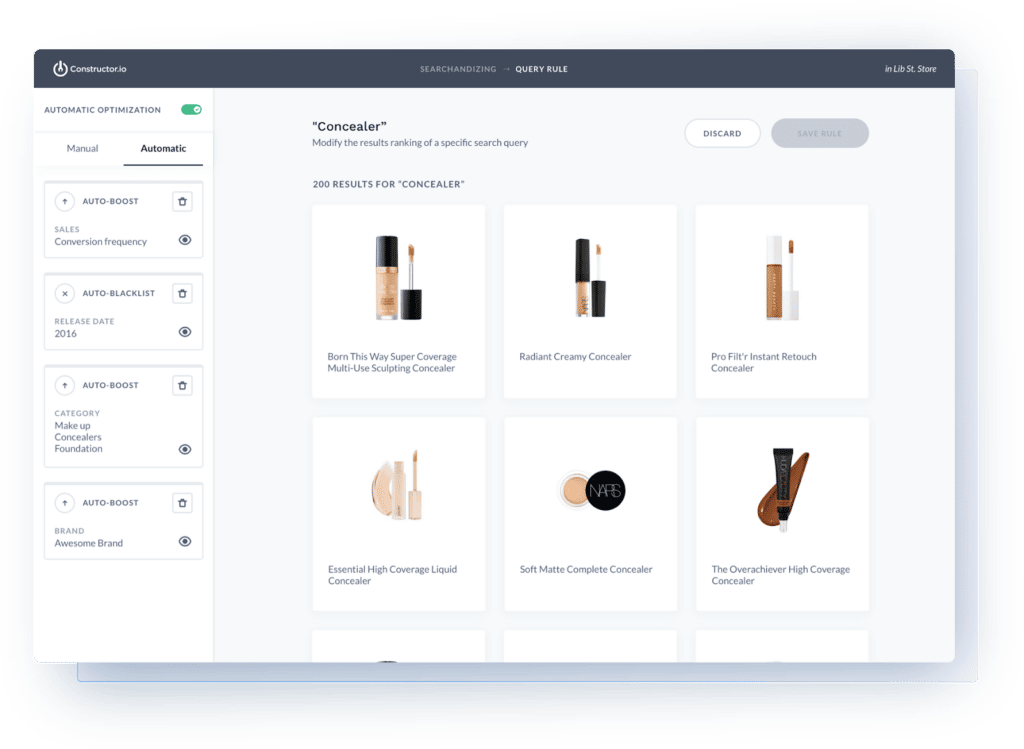
Sometimes, a company sells its own products alongside competitors. Walmart sells household and pantry staples alongside competitors under the label of Great Value. In such situations, you can push own-brand products to the top to optimize for margin.
You can also boost profitable products to make them move faster. For instance, if a dress sees increased sales in the wake of a viral TikTok, boosting it in searches can help increase sales.
Inventory size also presents various merchandising opportunities. For instance, companies can boost unpopular high-inventory products to make room for new models or bury popular products if their stock is low while awaiting renewal. More advanced merchandising tools allow you to set a specific time when a new product will be available.
Merchandisers can also boost and bury based on location. If the Seattle Seahawks have a home game, sports apparel retailers could boost Seahawks-branded jerseys in Washington.
Slotting
Sometimes, merely boosting isn’t enough. You might want to “slot” a new or own-brand product at the top. This functionality is a requirement for retailers that also sell own-brand products or are promoting products by a brand partner. In such cases, merchandisers can manually slot these products at the top of search results.
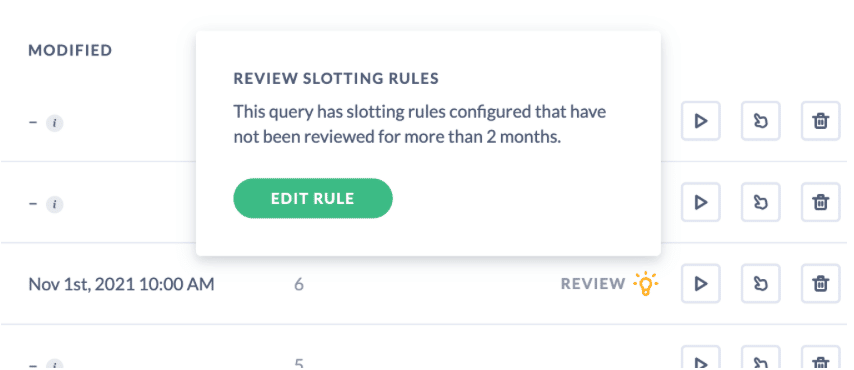
Blocklisting
Blocklisting is the ability to block products or groups of products from showing. This powerful tool allows merchandisers to further customize what is shown to customers. For example, they can block marijuana products from displaying to children or groups of out-of-stock products from showing to anyone.
Creating Custom Timed Collections
Is Thanksgiving around the corner? Or maybe your country is hosting the Olympics. Robust merchant tools allow merchandisers to customize themed collections of products in response to certain searches.
Collections don’t have to be events based. Outdoor retailer Backcountry created one such “Winter Hike” collection.

This type of page shows customers complementary products for an activity that might be new to them. It increases the chance that people will find other products that appeal to them and increase the size of their baskets. For example, a customer landing on this collection looking for a jacket for winter hiking might realize they should probably have a set of hiking poles too.
If the customer likes the products on this page, they may also click around on the rest of the website.
2. Understanding Your Customers
Your innate knowledge and experience as a merchandiser is critical. But it’s also helpful to dip in and get some first-hand knowledge on customer behavior. All the actions a user takes on your website tell you something about them. For example, clicking on two successive low-fat food items tells you they might prefer low-fat or health products. Adding them to cart is an even stronger signal.
This stream of actions — called clickstream — gives you a three-dimensional portrait about a person. This includes information about how they found your site, entry and exit points, items added or removed from the cart, and much more. You can personalize what you offer them and make smarter decisions about how to cater to the different categories of users they fall into by merchandising.
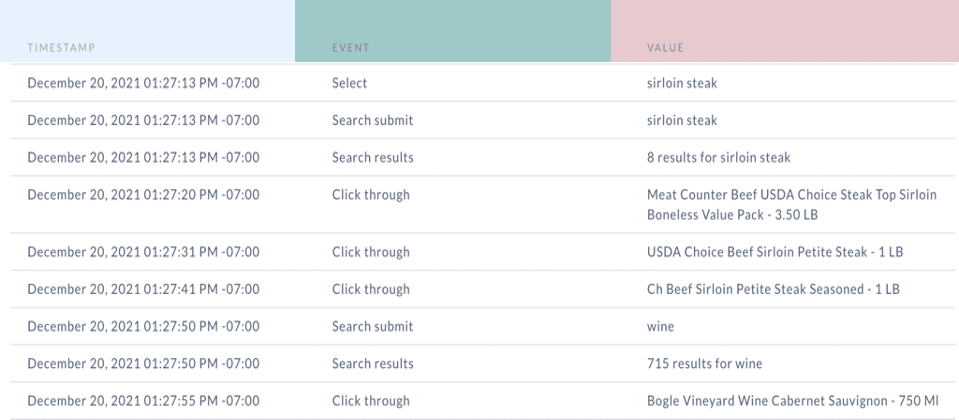
Uptick in searches for leather jackets? Maybe you can offer complementary items like boots to complete the look.
Low click-through for a well-known product? Maybe you need a new product description or image.
Clickstream data collected by a capable platform gives you granular data to give your customers exactly what they need at exactly the right time.
At this point, you may ask how to analyze billions of actions by millions of users. The answer is a merchant intelligence dashboard where AI surfaces behavior patterns at scale. Clickstream combined with customer logs, product dashboards, and AI analysis gives you the knowledge to searchandise with confidence.
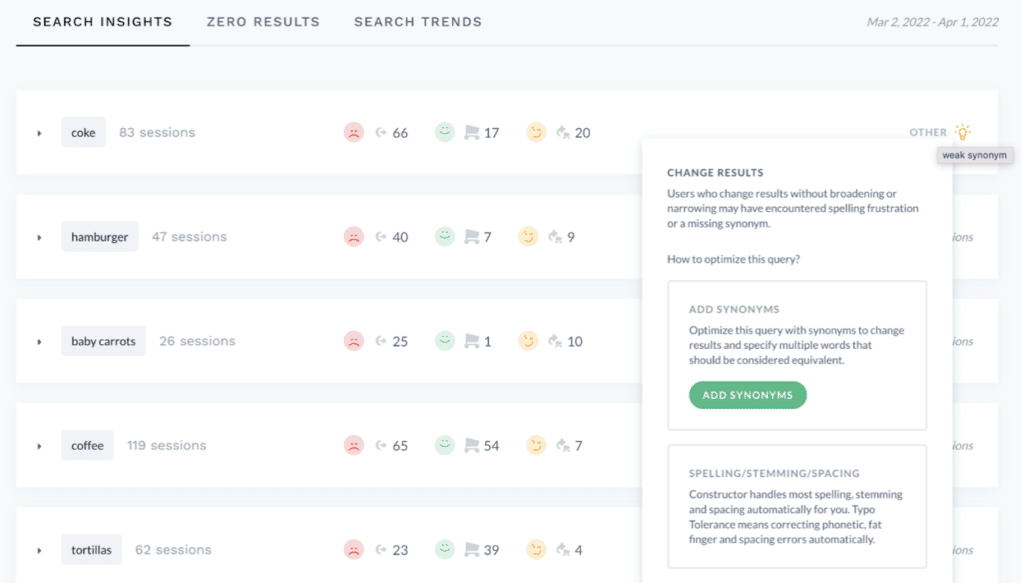
But for managing the vast majority of searches, merchandisers need tools.
3. Searchandising with AI Support
Merchandisers take pride in their work. Their bread-and-butter is understanding what buyers want and balancing it with company needs. But some are also stressed by the amount of work they have to do. Boosting, burying, writing, managing, and fixing synonyms can be grinding.
But modern platforms also provide merchandisers with a host of tools to support their work. Chief among them is artificial intelligence, which helps them focus on the more creative aspects of their job. That’s why merchant tools with AI and merchant intelligence are so effective.
Personalization
Sixty percent of consumers say they’re likely to become repeat buyers after a personalized experience. But with evolving expectations, people want to be catered to as people, not as groups. Demographics like gender, age, and location are only the beginning of personalization—we’ve moved beyond them.
Merchandisers can still use all these factors, but the next level of personalization (or hyper-personalization) is here. And it uses Artificial Intelligence and Natural Language Processing (NLP).
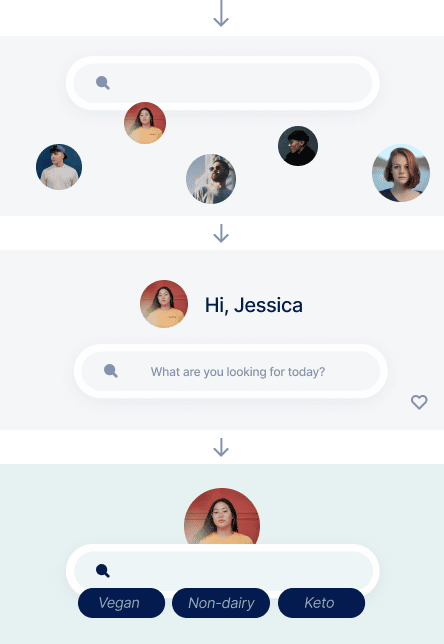
Say a user is looking for “organic berries” followed by “organic bananas.” Then they search for “milk.” By analyzing the behavior of this user and millions of others, a hyper-personalized search experience would provide organic milk near the top. So merchandisers do not have to spend as much time setting up complicated if/then rules. The AI takes care of most of the easily solved but hard-to-spot issues and fine tunes the human-made rules.
The numbers speak for themselves. Upscale apparel brand Bonobos gained 9% more search revenue when using a search and discovery platform capable of personalization.
Faceted Search
Facets are options that ecommerce companies give customers to refine their search criteria. Merchandisers usually set price range, brand, size, etc. as common facets. With filters, the user and the company searching for products collaboratively. But only 40% of companies set them up. After all, going through a product catalog, categorizing the products, and adding filters manually can be a pain.
Just like search results, filters and facets should be dynamic based on what users search for. Machine learning offers this opportunity.
So if a user is searching for “blazer,” the search results page may show facets like “fit” and “material” higher in the navigation rather than leaving a basic set of static clothing filters. If they’re searching for “pants,” options like “slim fit” or “inseam” would be available.
In the real world, decor retailer Rugs Direct provides facet options for the query “pillows” which are very different from those for the query “kitchen.” Effective facets were one factor that gave them a 16.5% lift in their Average Order Value after investing in an ML search and discovery platform.
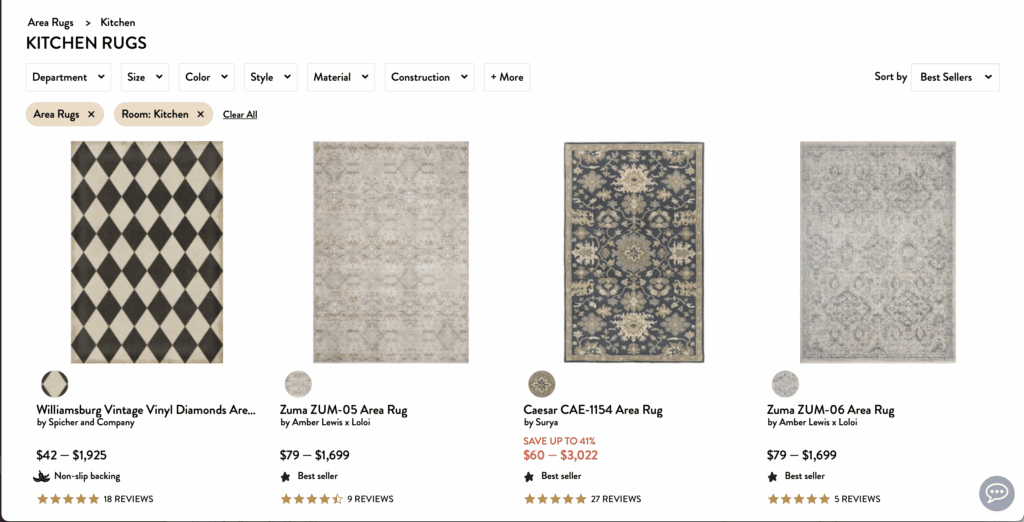

But it’s not at all machine-driven. Even here, the steady hands of humans guide the ML. With advanced facet management, you can show facets more prominently, adjust facet detail, or hide them.You can also use dashboard data to understand facet effectiveness.
You can also combine personalization with filters to make category pages even more dynamic. Clickstream data can make even “static” pages responsive. By understanding what millions of users do over billions of searches, the products in your collections are automatically ranked by the AI. This reduces manual work and allows you to focus on creative searchandising like researching trends, spotting gaps, improving the UI, and more.
Merchant Intelligence
We humans are excellent at spotting patterns and solving problems. But ecommerce companies deal with gargantuan amounts of data, which makes it very difficult to make sense of it all. Merchant intelligence tools use AI to analyze massive amounts of data and show patterns and actions to the merchandiser.
These tools can:
- Show customer patterns to merchants
- Show them the effects of merchandising actions before they are deployed
- Suggest follow-ups and best practices
These insights come from clickstream data. They allow you to solve the most pressing gaps and opportunities which even the AI cannot fix. This “managing by exception” frees you to tune at merchandising strategies with a global impact instead of being tangled up in the weeds.
One example of merchant intelligence is reviewing aging rules. Our data shows that merchants usually revisit rules 7 to 14 days after setting them. At any one time, they may have 1000s of active rules. Old, irrelevant, or underperforming rules can hurt revenue and KPIs.
Take a retailer like Target Australia. In the winter, they may have boosts on some knitwear. This may also include boosts on darker colors which are in fashion. But a rule like this may still be active and suppress warm-weather clothes as the spring approaches.

A merchant intelligence platform can alert merchandisers when the rules have been left unmodified for a while (in this case, more than two months). This enables the merchant to remove or retain the rule but with a clear eyed perspective on its impact on customer experience.
Zero/Frustrated Searches
There’s nothing quite as exasperating as a zero-result page for a product that’s in your catalog. Entire supply chains become dead weight if a customer can’t find a beanie when the supplier calls it a “knit cap.” Or the customer entered beanie on a moving bus as “brwani.” Or they forgot what it’s called and entered “winter hat.” We can see you yelling at the screen.
A related situation is when the customer finds the wrong results because of a bad search engine.
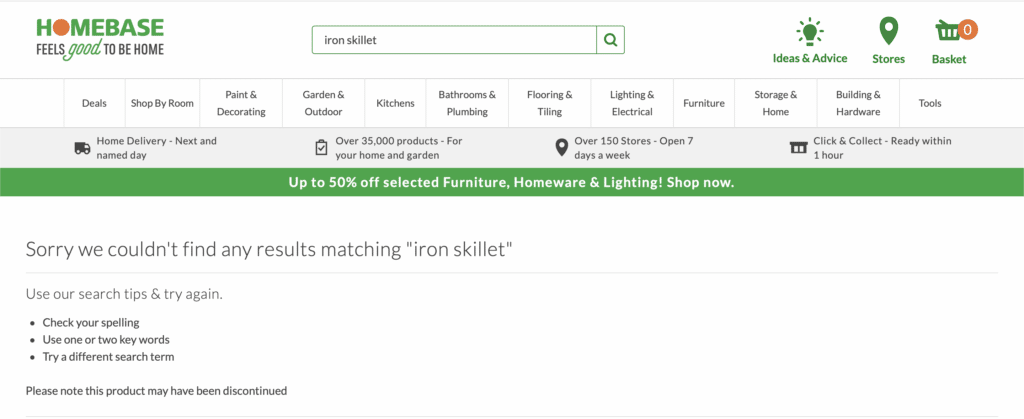
Such shenanigans are common with older search engines like Solr and Elastic, who are based in technology from the 1990s, before “google” was a verb. It’s a common occurrence, as up to 70% of search engines cannot return relevant results for product-type synonyms like “mobile phone” and “cell phone”. Besides eye-watering frustration, both these kinds of results contribute to retailers losing $300 billion a year from abandoned searches. Merchandisers also lose hours creating redirects, synonyms, and other fixes.
But an AI solution like Cognitive Embeddings Search (CES) learns from categories, product names, and text descriptions to solve the issue of synonyms and zero-result searches.
Instead of spending hours fixing synonyms and making redirects, merchandisers only have to manage by exception. Their work is rewarded because as they’re fixing synonyms, the AI is learning and making intelligent decisions about other related errors.
NLP Autocorrect and Autosuggest
Another AI technology is natural language processing powered autocorrect. Older engines dump synonym work on you and slow down searches, leading to lost revenue and company time.
But with AI, autocomplete is cognizant of how people actually type on the keyboard. Even misspelling skirt as “skyurt” still returns accurate suggestions. And you have fewer synonyms to correct.
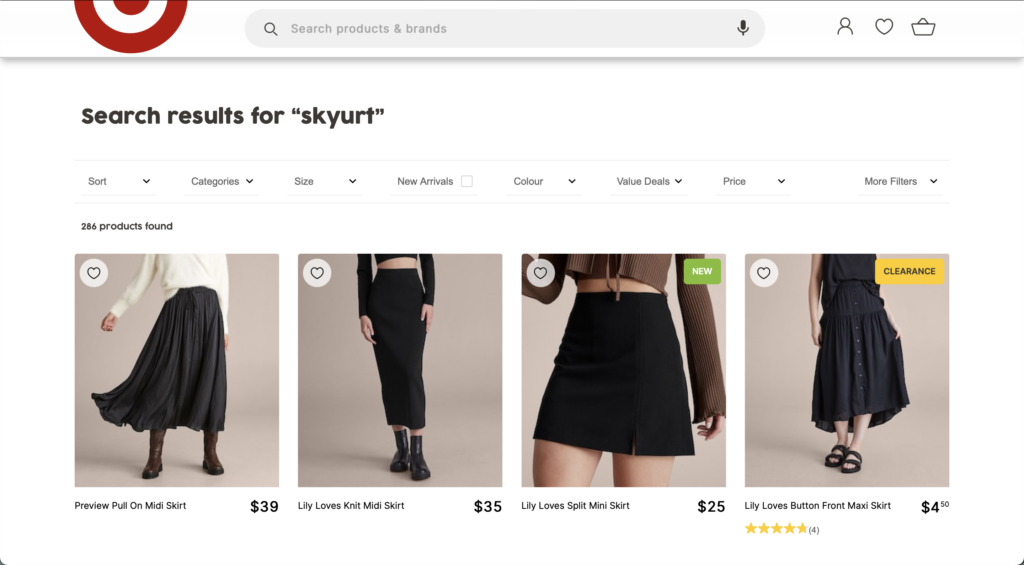
Autocomplete can also pair with CES to produce excellent suggestions. It can also have excellent autosuggest/autocomplete — guessing what people want as they type. The best systems also provide you with visual autosuggest so images are paired with suggestions for users. This is a valuable technology, as autocomplete can increase conversion rates by 22%.
By reducing cognitive demand on users, avoiding typos, and working in concert with NLP autocorrect, strong autosuggest/autocomplete strengthens the customer experience.
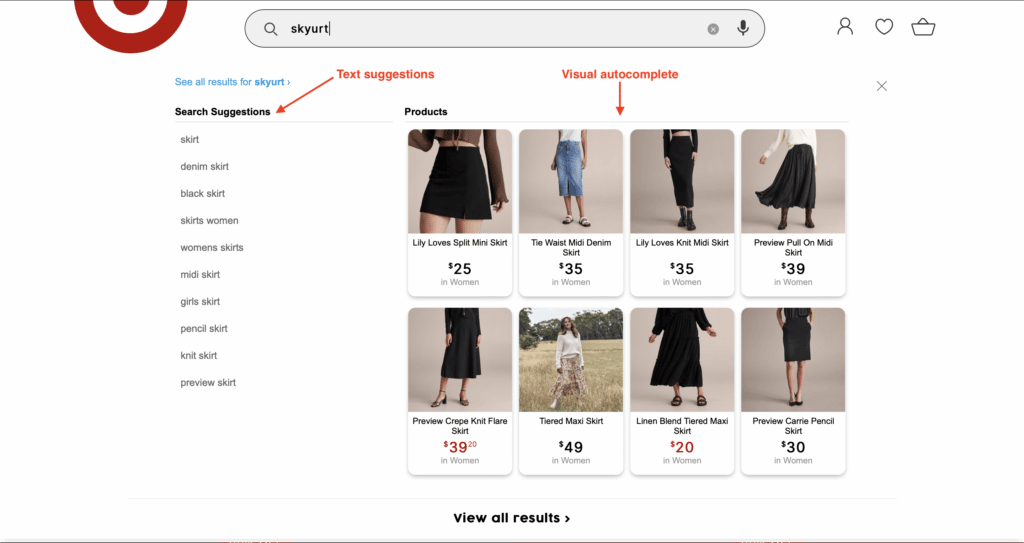
You Are in the Driver’s Seat
Searchandising is a hybrid term for a reason. It is most effective when merchandisers and technology work together. With AI taking on the most repetitive tasks, merchandisers can focus on “managing by exception.” They can work on the most pressing creative problems that AI cannot solve and we humans excel at.
By being a partner to you, searchandising lets you create a memorable and profitable experience unlike any other.
Even Ecommerce Superheroes Need A Sidekick
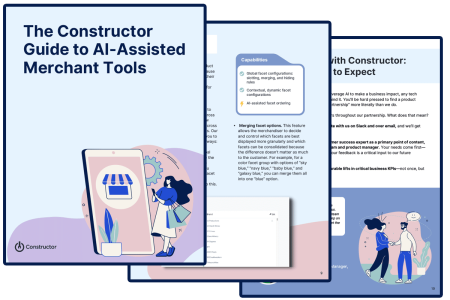
Ecommerce merchandisers are the champions of retail: managing a busy workload, creating personalized site experiences for customers, and driving on-site revenue. It’s a lot to balance.
But you can reduce your routine work and drive your KPIs with Krestor’s AI-assisted merchant tools helping you.
In this guide, we’ll dive into two areas where Krestor streamlines workstreams for your merchant teams:
- Site search and browse capabilities
- Sitewide product discovery
